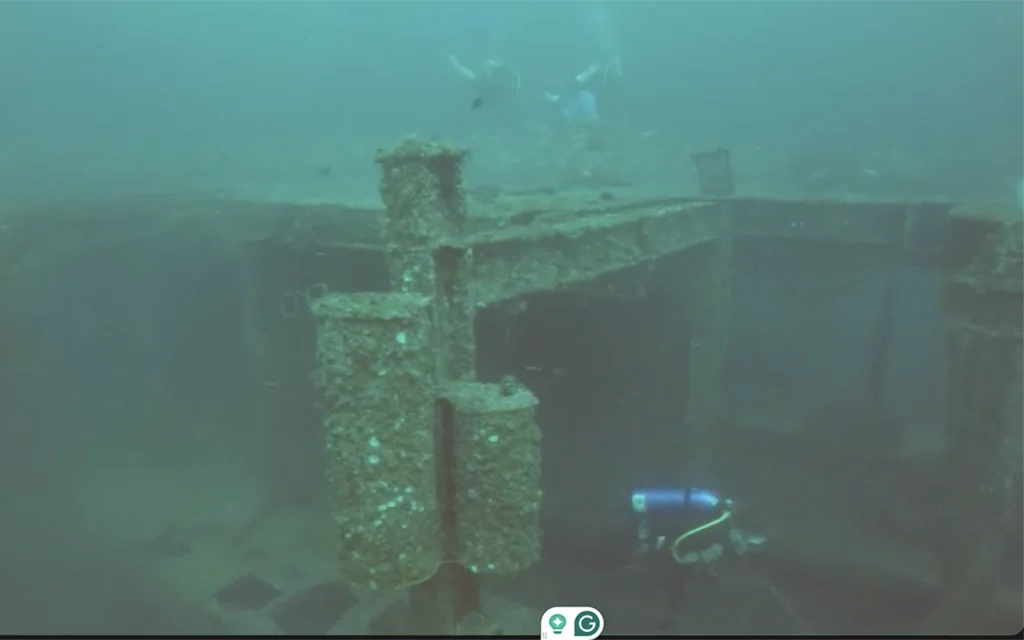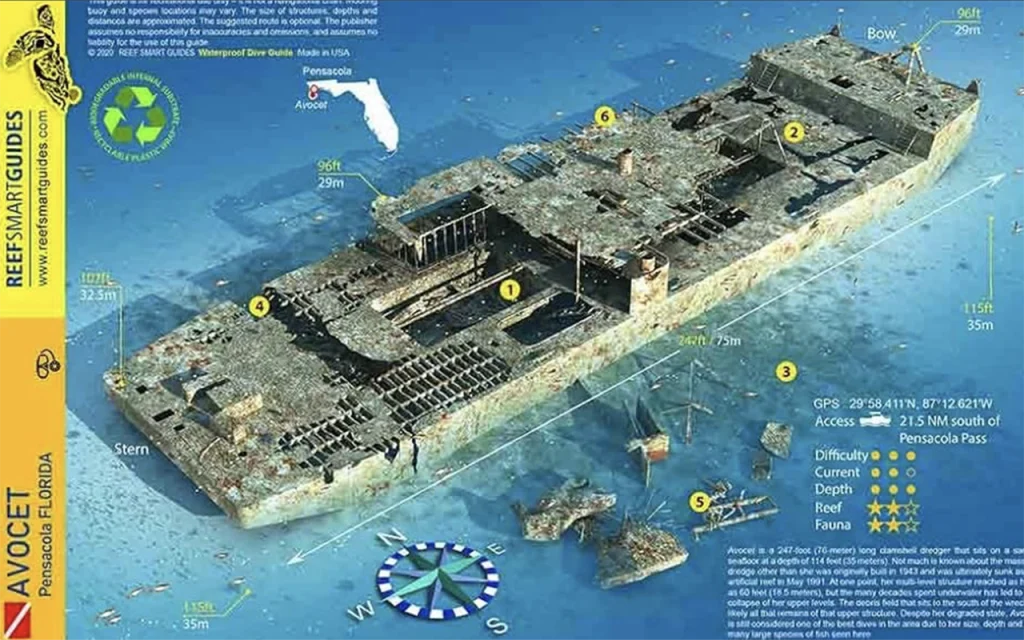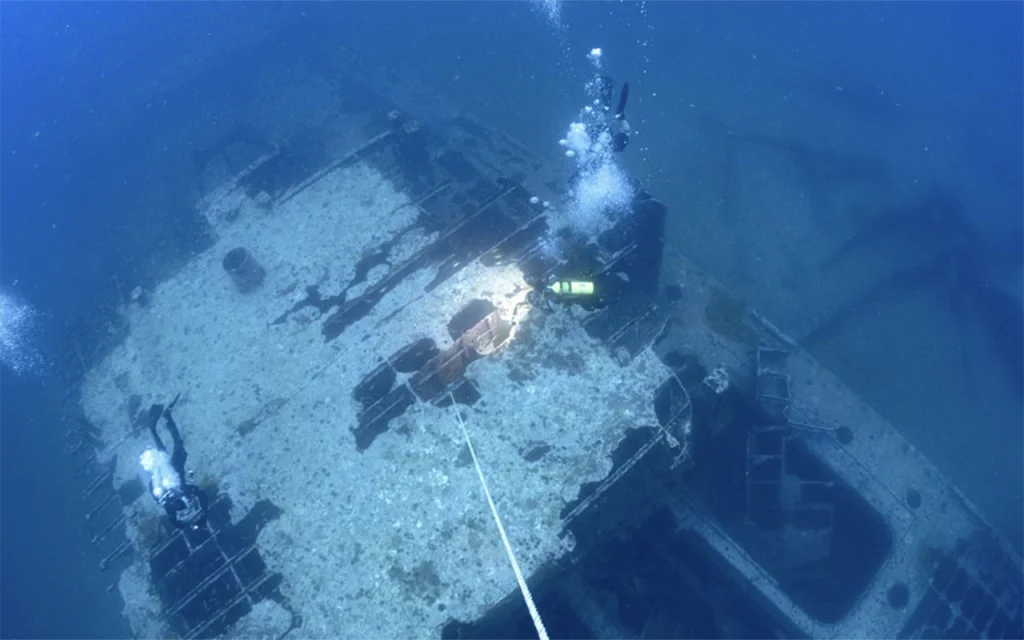Table of Contents

Overall, the combination of rich marine biodiversity, the wreck’s unique structure, and the dynamic diving environment makes the Avocet a standout destination for scuba divers.
Article at a Glance
- Location: 24 miles southeast of Pensacola, Florida (29.58.369’N, 87.12.603’W)
- Depth: 100-120 feet, with upper structure at 70-90 feet
- History: 247-foot clamshell dredger, intentionally sunk in 1991 as an artificial reef
- Unique Feature: Split into two sections by Hurricane Opal in 1995
- Marine Life: Home to pelagic fish schools, groupers, snappers, and various tropical species
- Diving Experience: Known for excellent visibility and diverse marine encounters
- Safety: Requires wreck diving experience; local dive shops offer guided trips
Depth
The wreck rests at a depth ranging from 100 to 120 feet, with the upper structure accessible at around 70 feet. Over time, the wreck has separated into two sections about 7 feet apart.
Location Coordinates
The Avocet wreck, a 247-foot clam shell dredge, is located approximately 24 miles southeast of Pensacola, Florida. The coordinates for the wreck are:
- Latitude: 29.58.369’N
- Longitude: 87.12.603’W

What Scuba Divers Say About This Wreck
- Abundance of Marine Life: Divers frequently mention the rich marine biodiversity surrounding the wreck. One diver noted encountering an abundance of life, including a memorable sighting of four spotted eagle rays during their dive.
- Schooling Fish: The wreck is known for its impressive schools of pelagic fish, which create a vibrant underwater atmosphere. Divers often describe the experience as overwhelming due to the sheer number of fish present.
- Depth and Structure: The wreck’s upper structure is located at approximately 90 feet, making it accessible for divers with appropriate certification. The wreck’s depth and the layout provide various exploration opportunities, with divers noting that the upper structure can be accessed at around 70 feet.
- Diving Experience: Many divers express excitement about the dive, often referring to it as a site with “never-ending surprises.” The combination of the wreck’s history, the marine life, and the underwater scenery contributes to a memorable diving experience.
What Kind of Marine Life Can Be Found on The Wreck
- Pelagic Fish: The wreck attracts large schools of pelagic fish, including cobia, amberjack, barracuda, and African pompano. Divers often report mesmerizing encounters with these shiny fish, which are known for their long streamers trailing from their dorsal and ventral fins.
- Bottom Fish: Inside the wreck, divers can find goliath grouper, vermilion snapper, and Gulf toadfish (locally known as mother-in-law fish). The structure of the wreck provides numerous hiding spots, allowing these fish to thrive.
- Lobsters: Both spiny and slipper lobsters are commonly spotted sheltering in the wreck’s nooks and crannies, contributing to the wreck’s biodiversity.
- Tropical Fish: The surrounding area is rich with various tropical species, including angelfish, butterfly fish, gobies, blennies, and batfish, enhancing the underwater scenery for divers.
- Other Marine Life: The wreck also attracts sea turtles and sharks, adding to the excitement of the dive experience.
Key Information
| Aspect | Details |
|---|---|
| Name | Avocet |
| Type | Clamshell dredge |
| Length | 247 feet |
| Tonnage | 2,640 tons |
| Sinking Date | May 1991 |
| Purpose | Artificial reef |
| Location | 24 miles southeast of Pensacola Pass |
| Coordinates | 29°58.369’N, 87°12.603’W |
| Depth | 115 feet (bottom), 80 feet (deck) |
| Visibility | Often exceeds 60 feet |
| Current Status | Split in two sections (7 feet apart) |
| Notable Marine Life | Cobia, amberjack, African pompano, goliath grouper |
| Best Time to Dive | May to October |
| Dive Difficulty | Advanced |
What Makes The Avocet a Unique Diving Experience
- Artificial Reef: Sunk in May 1991, the Avocet serves as an artificial reef, providing structure in deeper waters that attracts a diverse array of marine life. The wreck has become a habitat for numerous species, making it a vibrant underwater ecosystem.
- Abundant Marine Life: Divers frequently encounter large schools of pelagic fish, including cobia, amberjack, barracuda, and the unusual African pompano. The wreck also houses goliath grouper, vermilion snapper, and various lobsters, contributing to an exciting diving experience.
- Depth and Structure: The wreck lies at a depth of approximately 115 feet, with the deck at around 80 feet. This depth allows for good visibility, often exceeding 60 feet, which enhances the overall diving experience.
- Dynamic Environment: The wreck was originally intact but was split into two pieces by Hurricane Opal in 1995, creating new areas for exploration. Divers can peer inside the wreck, discovering numerous nooks and crannies filled with marine life, which adds an element of adventure to each dive.
- Visual Appeal: The presence of shiny pelagic fish and the structure of the wreck itself create a visually captivating environment. Divers often describe the experience as mesmerizing, with the vibrant colors and movements of fish enhancing the underwater scenery.
What is The Full History of This Wreck
Construction and Purpose
- Type of Vessel: The Avocet was a 2,640-ton clamshell dredger, designed for dredging operations.
- Operational History: Before its sinking, the Avocet was actively used for dredging tasks. Its operational life spanned from its construction until it was intentionally scuttled in 1991.
Sinking as an Artificial Reef
- Deliberate Sinking: In May 1991, the Avocet was deliberately sunk approximately 21 miles south-southeast of Pensacola Pass, Florida. The sinking was executed by the Reefmaker team, led by David Walter, and was intended to create an artificial reef to enhance local marine habitats.
- Initial Condition: Upon sinking, the wreck was intact and upright, providing a stable structure for marine life to colonize.
Impact of Hurricane Opal
- Destruction and Transformation: In October 1995, just four years after its sinking, Hurricane Opal struck, causing significant damage to the wreck. The storm split the Avocet into two distinct sections, approximately 7 feet apart. This alteration created new opportunities for divers, as they could now explore the interior of the wreck, which became a haven for various marine species.
Current Status
- Diving Site: Today, the Avocet wreck lies at a depth of about 115 feet, with its deck at approximately 80 feet. It has become a popular dive site, known for its rich marine biodiversity, including large schools of pelagic fish and various bottom-dwelling species.
- Marine Habitat: The wreck now serves as an artificial reef, attracting a variety of marine life, including goliath grouper, vermilion snapper, and lobsters, making it a vibrant ecosystem for divers to explore.

What Historical Features Can Still Be Identified on Wreck
- Original Structure: The Avocet was a 2,640-ton clamshell dredger, and remnants of its original structure can still be observed. The wreck was designed to be upright and intact when it was scuttled in May 1991, and although it has split into two sections due to Hurricane Opal in 1995, significant parts of its hull and upper structure remain recognizable.
- Dimensions and Depth: The wreck measures approximately 247 feet in length and rests at a depth of about 115 feet, with its deck at around 80 feet. These dimensions are crucial for divers to navigate and understand the wreck’s layout.
- Interior Features: Divers can explore the interior of the wreck, where various marine species take shelter. Although penetration is limited, there are numerous nooks and crannies that showcase the wreck’s construction and provide habitats for marine life, such as goliath grouper and lobsters.
- Artificial Reef: As a purpose-sunk artificial reef, the Avocet has transformed over the years into a thriving ecosystem. The wreck’s design and structure provide essential habitats for a variety of marine life, making it an important site for both ecological and recreational diving.
- Marine Life Interaction: The historical significance of the wreck is enhanced by the diverse marine life that now inhabits it. The presence of pelagic fish, such as cobia and amberjack, alongside bottom-dwelling species, creates a dynamic environment that reflects the wreck’s historical purpose as a dredger and its current role as a reef.
What Safety Measures Are in Place for Divers Visiting The Avocet
- Pre-Dive Preparation: Divers are encouraged to arrive early for a shallow warm-up dive. This helps ensure that equipment is functioning properly, weight is adjusted, and divers are comfortable before proceeding to deeper dives at the wreck.
- Specialized Training: It is recommended that divers have proper training in wreck diving techniques. This includes understanding how to navigate the wreck, recognizing potential hazards, and knowing how to manage buoyancy effectively to avoid silt-outs or debris falls during penetration.
- Appropriate Gear: Divers should utilize specialized equipment for wreck diving, including bright lights for visibility in dark areas, cutting tools for potential entanglements, and reels to mark paths through complex structures. A dual-outlet-valve system is also advised for redundancy in case of equipment failure.
- Limited Penetration: While divers can explore the wreck, penetration is limited. This precaution helps reduce risks associated with confined spaces and ensures that divers do not become disoriented or trapped.
- Monitoring Conditions: Divers should be aware of the depth and current conditions at the site. The Avocet wreck is located at depths ranging from 90 to 130 feet, and understanding these factors is crucial for safe diving.
- Local Dive Operators: Engaging with local dive professionals and operators can provide valuable information about the wreck, including its layout and any recent changes due to environmental factors. They can also assist with safety briefings and equipment checks.
Dive Shops That Prove Diving Trips to This Shipwreck
- Dive Pros
- Rating: 4.9
- Reviews: 171
- Address: 7203 US-98, Pensacola, FL 32506
- Dive Pros is known for its experienced staff and comprehensive dive services, including trips to the Avocet wreck.
- Niuhi Dive Charters
- Rating: 4.9
- Reviews: 82
- Address: 10139 Sinton Dr, Pensacola, FL 32507
- Niuhi Dive Charters specializes in various dive sites, including the Avocet, and offers guided trips for divers.
- Emerald Ocean Divers
- Rating: 5.0
- Reviews: 2
- Website: Emerald Ocean Divers
- This dive shop provides personalized dive experiences and includes the Avocet wreck in its offerings.
- DiversEd
- Rating: 5.0
- Reviews: 58
- Address: 2404 Jewell Lee Ln, Pensacola, FL 32526
- DiversEd offers a range of diving courses and trips, including excursions to the Avocet wreck.
North Florida Wrecks
- USS Oriskany
- USS Massachusetts
- SS Tarpon
- SS Gulf America
- Empire Mica
- USS Chippewa
- Avocet
- Black Bart
- The Vamar
- San Pablo
- USS Narcissus
- The Loftus Wreck
- The Dorothy Louise
- The Mizpah
- MV Janet
- The Eidsvag
- YDT-14 and YDT-15
- USS Strength
- Miss Louise
- The Lulu
- PC-1174
- Three Coal Barges
- USS Accokeek (ATA-181)
- El Dorado
- The Grey Ghost
- The Pete Tide II
- Red Sea Tug





